Despite our recent weeks of summer fun, fall is definitely in the air in the Pacific Northwest. I’m ready to leap into fall with this seasonal color palette and in-the-pot swirl soap. Check this out if you’ve been on the hunt for a great palm-free recipe, and check out another palm free recipe here and here. This recipe turns out super hard and the bubbles are medium in size with an easy rinse-off.
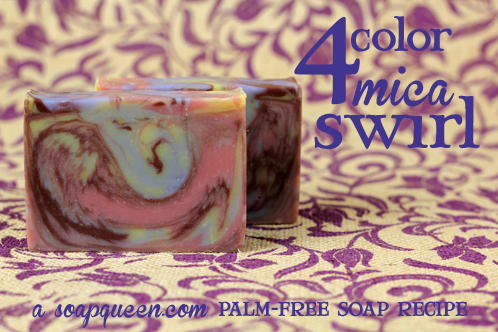
20.0 oz Coconut Oil
40.0 oz Rice Bran Oil
8.3 oz Sodium Hydroxide (Lye)
19.8 oz Distilled Water
3.5 oz Earl Grey Lemon Fragrance Oil
3 teaspoons Merlot Mica
2 teaspoons Super Pearly White
1 teaspoon Cellini Blue Mica
1 teaspoon Cellini Yellow Mica
1 teaspoon Cappuccino Mica
2 tablespoons Sweet Almond Oil
5 Pound Wood Mold with Sliding Bottom
Buy everything you need for this project with the click of a button!
For more tactile learners, this tutorial is available in our Etsy shop! Get your hands on printed instructions and a bar of soap and learn to make this palm-free soap here.
If you have never made cold process soap before, I highly recommend you get a couple of basic recipes under your belt. Check out this (free!) 4-part series on cold process soap making, especially the episode on lye safety. Bramble Berry carries quite a few books on the topic as well, including this downloadable book on making cold process soap.
SAFETY FIRST: Before getting started, suit up in the proper safety gear: goggles, gloves, long sleeves. Make sure that kids and pets are out of the house or in another room without potential for distraction or tripping hazards, and ensure that your soaping space has excellent ventilation.
COLOR PREP: Disperse the oil soluble Yellow and Blue Micas in Sweet Almond oil at a rate of 1 teaspoon mica to 1 tablespoon oil. Mix well using a mini-mixer, but be sure to saturate the powders with oil before turning on the mixer or you’ll get a messy cloud of pigment! Once the oil soluble micas are dispersed, blend the Merlot Mica and Super Pearly White Mica to create a lovely pink color.
ONE: In a well ventilated area, slowly and carefully add the lye to the water. Stir until clear and set aside to cool.
TWO: Melt and combine Coconut Oil and Rice Bran Oil. When the lye water has cooled to 130 degrees or below, slowly add the lye water to the oils and stick blend until a light trace is achieved.
TREE: Separate your soap batter into 4 parts, three weighing 24 oz and one weighing 16 oz.
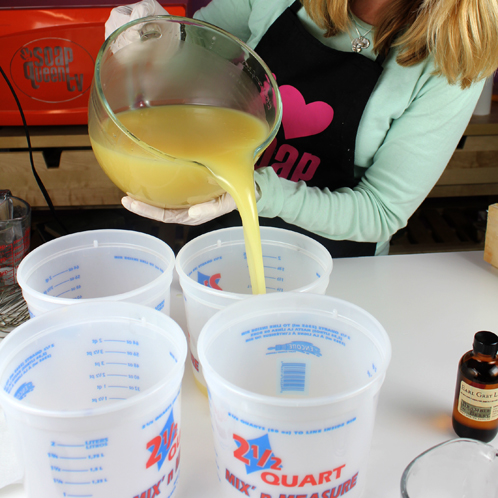
FOUR: Color one of the 24 oz batches with 3 teaspoons dispersed Cellini Blue Mica, the second 24 oz batch with 3 teaspoons dispersed Cellini Yellow Mica, the third 24 oz batch with 5 teaspoons (all of the) Super Pearly White + Merlot Mica mixture, and the 16 oz batch with 1 teaspoon Cappuccino Mica. Mix each of the colorants in until fully incorporated.
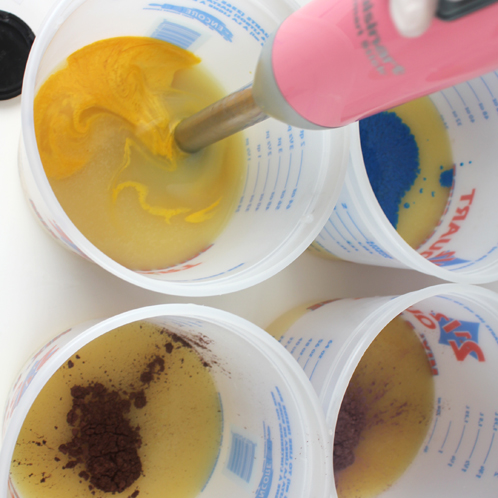
TIP: Want to do less dishes in the end? Mix in your colorants from lightest color to darkest color so you can use the same mixing tool!
FIVE: Fragrance each of the colored batches with Lemon Earl Grey Fragrance Oil. Reserve about an ounce of each of the colored and scented batches in a separate container. We’ll get to those in a moment!

SIX: For the in-the-pot swirl, start by pouring the Cellini Blue colored soap into the Cellini Yellow soap in 4 places: 12:00 o’clock, 4:00 o’clock, 8:00 o’clock, and center. Repeat with Super Pearly White + Merlot and Cappuccino colored soap. Pour from a high point so that the soap penetrates the entire depth of the soap in the pot, which will create a swirl throughout the soap. Using a spatula, chopstick or dowel, swirl the soap by running the tool through each of the entry points once. Only once! You want to swirl not mix the soap, and there will be a bit of further swirling when the soap is poured into the mold.
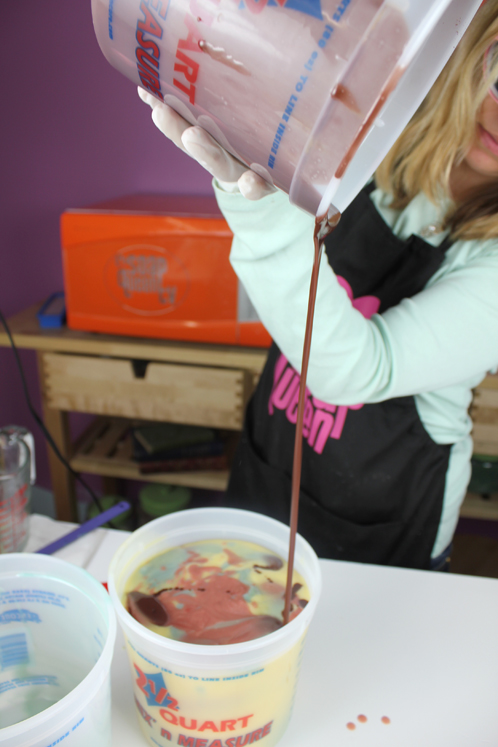
SEVEN: Pour the swirled soap into the mold. Tamp the mold on the tabletop to eliminate any air bubbles.
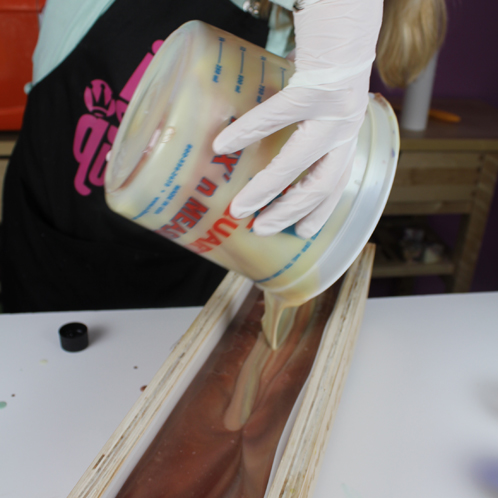
EIGHT: Remember the soap we reserved earlier? It’s showtime! Start with the color of your choice (I did yellow first) and pour over the top of the soap in an a wide s-curve running down the length of the mold. Follow that s with the next color and the next.
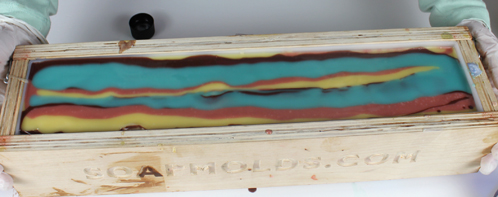
NINE: Drag a chopstick or dowel inserted into the top 1/4″ of the soap down the length of the mold, making a series of short s-curves that are perpendicular to the s-curve created by the poured soap. Once you’ve gone from one end of the soap to the other, lift the swirling tool out of the soap and start again where you did the first swirl, except this time make loop-dee-swoops down the length of the mold following the original s-curves.
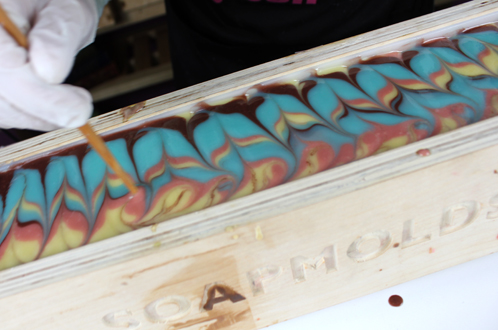
TEN: Spray the entire top with 91% Isopropyl Alcohol to help prevent soda ash. Cover and insulate for 24 hours and unmold after 3-4 days. Allow to cure for 4-6 weeks and enjoy!
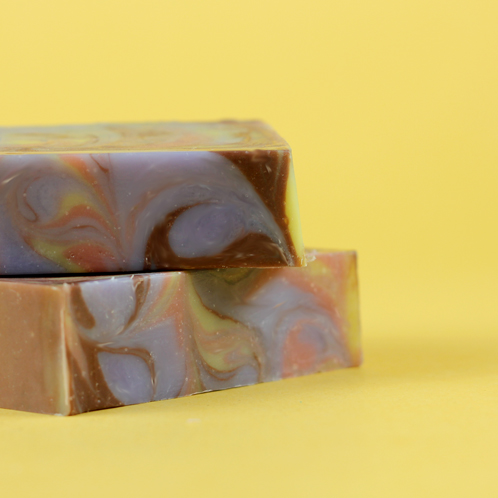
Are you a visual learner? You can buy this soap to check it out and see printed instructions here.

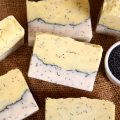

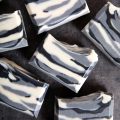
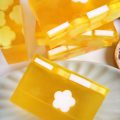
Hi, I am loving your tutorials! I have a couple questions about this particular recipe.
Does the soap get hard using only Rice Bran and Coconut Oils?
Does the rice bran effect the color of the soap?
Hi Jamie,
Thanks for stopping by! This soap gets pretty darn hard using just the Rice Bran Oil and Coconut Oil. Rice Bran Oil on it’s own will produce a somewhat hard bar but can take a while to cure, so the addition of Coconut Oil helps facilitate the hardening of the bar.
There might be some slight discoloration because of the natural color of the Rice Bran oil (as opposed to a recipe using, say, Palm, Coconut and Canola Oils) however I’ve never found that any discoloration from the oil has been enough to effect any colorants added.
I hope this helps! Let us know if you have any further questions =)
Kristen with Bramble Berry
Thank you so much!
I was wondering what the weight of the finished bars are. More specifically, is there a way to say “I need 8 bars of 4.5 oz each after cure, so I need my initial recipe to be X ozs”? Does 100% of the water evaporate out?
Hi Misty!
It actually varies by recipe, and in some recipes it can be as much as 40% of the water evaporating out. The best way to figure it out for your recipe, would be using the calculations found in these blog posts by Marie Gale so that you’ll be able to do the calculations for any recipe that you come up against.
http://blog.mariegale.com/calculating-net-weight-soap-part-1/
http://blog.mariegale.com/calculating-net-weight-soap-part-2/
I hope this helps! Let me know if you have any other questions. =)
-Becky with Bramble Berry
I am curious about how to spray the entire top with 91% Isopropyl Alcohol? Rubbing alcohol is a liquid product. Can you buy a spray bottle of rubbing alcohol from the market?
Hi Angela!
Unfortunately there isn’t a spray bottle of rubbing alcohol at the stores. We just buy the isopropyl alcohol and then use a spray top bottle, and have found that it works really well.
8 oz Bottles (Spray Top): https://www.brambleberry.com/8-oz-Bottles-Spray-Top-P4457.aspx
I hope this helps! 🙂
-Becky with Bramble Berry
Hi!
I was wondering if the aqua pearl mica would work in this color scheme as a replacement for the cellini blue? I love that turquoise & brown color combo but was thinking it may be too light a color from the look of it in cold process soap on Brambleberry’s site. Can it be made dark enough to reach the same tone as the cellini blue? The color I am going for is the color that the cellini blue looks before it hardens as in the pics of Ann Marie pouring it from the plastic containers in the above pictures.
Also, I made a large batch of lavender soap that I tried to color a light purple with Ultramarie Violet oxide and it looks a yucky brownish gray color. I used the recommended amount of color ( 1tsp dissolved in 1/3 cup oil, then 1tsp of this premixed color per pound of ouls) and it was no where near enough even after I added more! :(. Is there any way to make this any more attractive? Such as rebatching it somehow witha different pigment?
Thanks for any help!
Good morning, Vicki!
I think the Aqua Pearl Mica would be a great choice for this soap and could definitely make it pop! If you are worried about how it comes across in CP soap, you can check out this soap that we recently used the Aqua Pearl Mica in:
Circle Swirled Soap in Column Mold: http://www.soapqueen.com/bath-and-body-tutorials/cold-process-soap/circle-swirled-soap-in-column-mold/
The Ultramarine Violet does tend to come across as a light purple in cold process soaps. But, you can definitely add more colorant to your next batch (and rebatch this soap) as well as adding a bit of Ultramarine Blue to get a more deeper, darker and vibrant purple color!
Ultramarine Blue: https://www.brambleberry.com/Ultramarine-Blue-medium-Pigment-P4043.aspx
I hope this helps!
-Becky with Bramble Berry
With this particular recipe – how long does it take for the soap to really harden? It seems like it would be rather soft.
Hi Sue!
This recipe is a bit softer than normal recipes and can take up to a week to harden without the palm. But, if you are worried about it hardening, you can always add a salt solution or Sodium Lactate to help it out! 🙂
Sodium Lactate: https://www.brambleberry.com/Sodium-Lactate-P5127.aspx
-Becky with Bramble Berry
How long would you leave it in the mold to harden? I’m having alot of trouble unmolding this one. it’s the third day now, and i’ve bought a rubber mallet, stuck it in the freezer for 20 min, took it out and banged on it. No movement! I did line with freezer paper… so i guess i’ll be taking my mold apart. It did get really hot. I felt the top of the towels that evening and it seemed hotter than some other CP recipes. Would this have an effect on how hard it is to get out of the mold?
Thanks!
andrea.
Hi Andrea!
You should only have to leave your soap in the mold as much as long as you would a regular cold process recipe if you have added the Sodium Lactate.
If you could tell me a little bit more about your recipe, I could definitely help you troubleshoot! =)
-Becky with Bramble Berry
waou..
great swirls.
love your big jar for soapmaking. I do not find this yet in France.
Hi Swanee!
You should be able to the big pouring jar through KitchenAids website! 🙂
-Becky with Bramble Berry
I took my cp soap class (for the first time) this past Saturday. I have always read all your blog posts about cp soap, even when I didn’t know how to make them. This is the second time I read about “spraying the top with 91% alcohol to prevent soda ash” and wanted to know if you have to do it always, or when do you should do it.
Thanks!!
Hi Sharlene!
You don’t always have to spray the top of your cold process soaps with rubbing alcohol, but it is a great preventive measure against soda ash. So, if you are finding that you are continually getting soda ash, spraying your soap would be a good idea. If you find that you don’t get any soda ash, you don’t necessarily have to spray it. 🙂 I hope this helps!
-Becky with Bramble Berry
Yes! Thanks =)
Hi
I always get soda ash and when I spray the tops liberally with the 91% alcohol it only reduces it. What causes it? Any other ideas?
Good morning, Dawnia!
The best way we have found to prevent soda ash is to spray the soap liberally with the 91% rubbing alcohol and then cover it with a cardboard (or towel). Doing that will also help prevent the soda ash. Pouring at a thicker trace, doing a slightly lower superfat and lowering the amount of water you use can also help. And, if you still find soda ash on your soap, all you need to do is wash it with a nylon piece and some cold water and it will come right off! 🙂
-Becky with Bramble Berry
It looks great. I’ve had a problem with essential oils fading in palm free recipes especially citrus ones and have tried adding clay. Is it my imagination or is it true that when you don’t use palm oil for essential oil blends they fade. I don’t have this problem as much with palm recipes.
That would not surprise me that you’re finding differences in performance with essential oils and fragrance oils by changing the recipe. Citruses are really prone to wafting away in CP anyways. You can anchor those scents a bit with a little Lemongrass or Litsea or a deep base note like Clary Sage or Patchouli to help the more delicate top notes from some of those citruses to come through.
Thanks I’ve tried the other EO’s before but not Clary Sage. Just find my palm oil recipes hold the citrus scents better then my palm free ones so have come to the conclusion that palm free is best for strong floral/deep base eo’s or fragrance oils.
Il est vraiment superbe!!! quel beau mariage de couleur
belle journée
Quelle bonne idée! Ces couleurs serait idéal pour un mariage. 🙂
Becky-Bramble Berry avec
What a great idea! These colors would be great for a wedding. 🙂
-Becky with Bramble Berry
So beautiful! I love the swirl and especially love the colors!
When you calculate the lye and water for this recipe, do you account for the sweet almond oil and fragrance?
Hi Jaime!
For this recipe, the amount of the Sweet Almond Oil is so low that it isn’t going to affect the recipe and you don’t need to account for it while running your recipe through the lye calculator. It’s basically acting as an additive. 🙂
-Becky with Bramble Berry
Very nice. I love the Earl Grey Lemon…smells so fresh.
The Earl Grey Lemon is one of my new top 10 scents, I just love the way it smells, it’s so sophisticated, yet fruity! 🙂
-Becky with Bramble Berry
Love, love, love those colors! So striking.